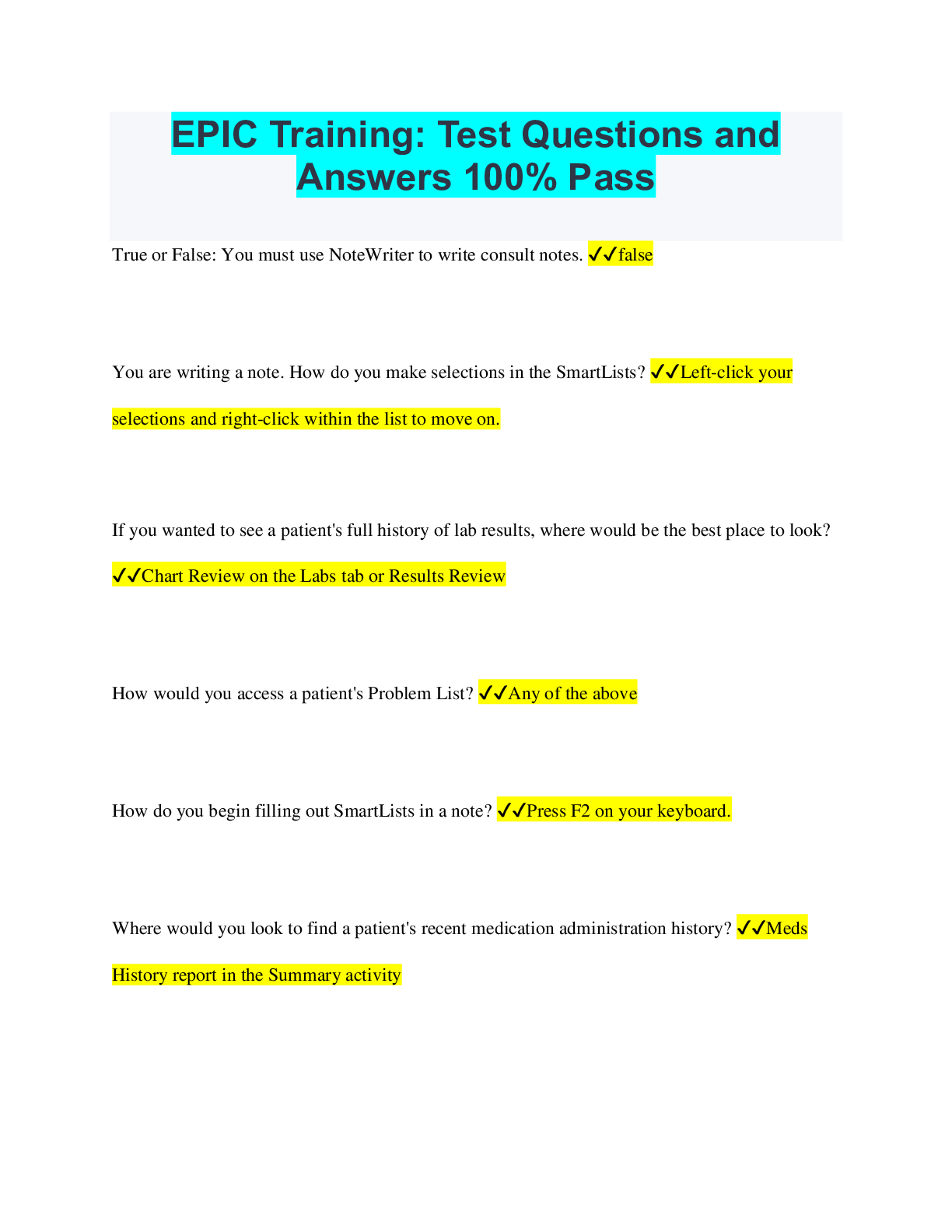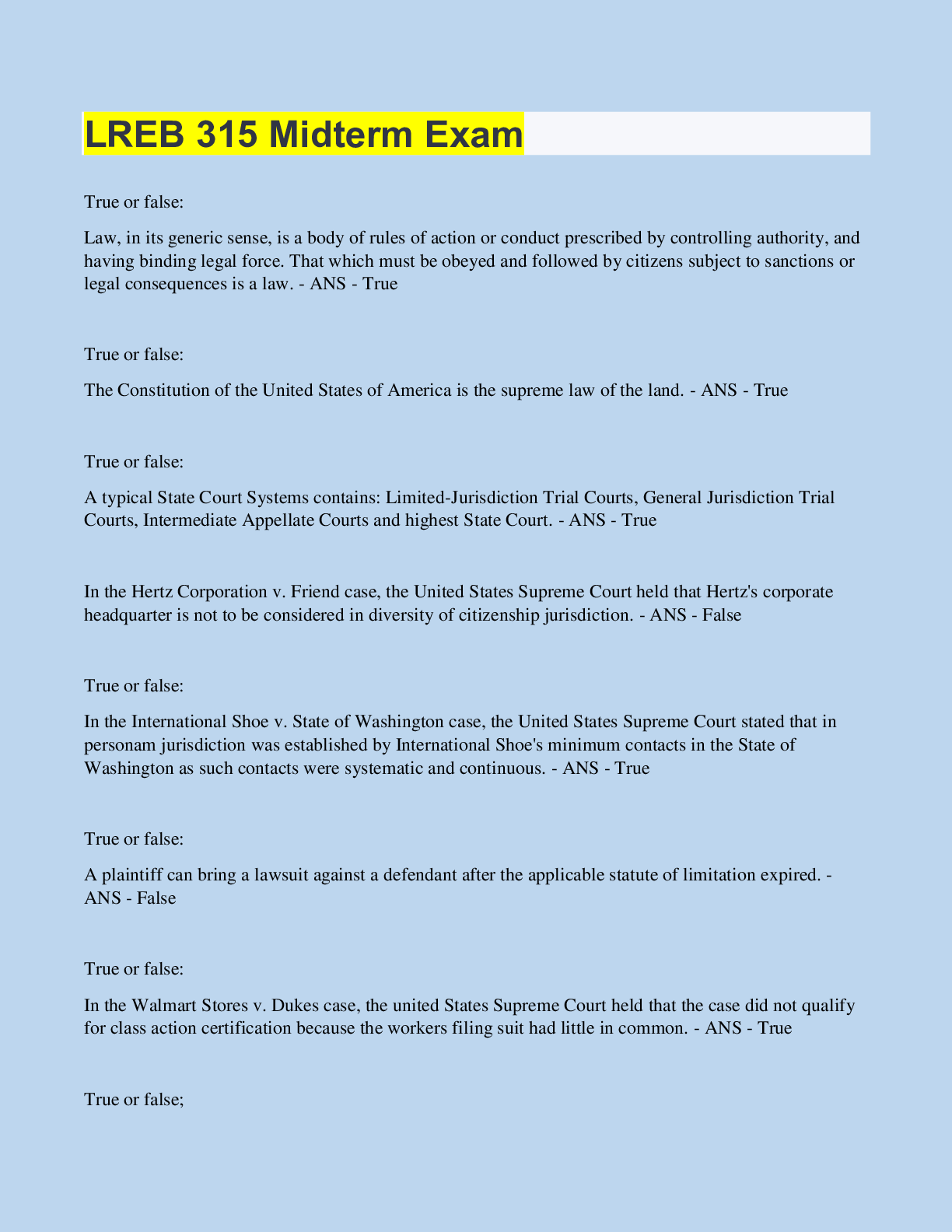Information Technology > QUESTIONS & ANSWERS > IT Security: Defense against the digital dark arts. Week2: Pelcgbybtl (Cryptology) Already Passed (All)
IT Security: Defense against the digital dark arts. Week2: Pelcgbybtl (Cryptology) Already Passed
Document Content and Description Below
IT Security: Defense against the digital dark arts. Week2: Pelcgbybtl (Cryptology) Already Passed What are the components that make up a cryptosystem? Check all that apply ✔✔encryption algorit... hms decryption algorithms key generation algorithms; A cryptosystem is a collection of algorithms needed to operate an encryption service. This involves generating encryption keys, as well as encryption and decryption operations. What is steganography? ✔✔the practice of hiding messages; Steganography involves hiding messages, but not encoding them. What makes an encryption algorithm symmetric? ✔✔the same keys used for encryption and decryption; The symmetry of a symmetric algorithm refers to one key being used for both encryption and decryption. What's the difference between a stream cipher and a block cipher? ✔✔Stream ciphers encrypt data as a continuous stream, while block ciphers operate on chunks of data; A stream cipher takes data in as a continuous stream, and outputs the ciphertext as a continuous stream, too. A block cipher encrypts the data in chunks, or blocks. True or false: The smaller the encryption key is, the more secure the encrypted data is. ✔✔false; The reverse is true. The larger the key, the more secure the encrypted data will be. Which of the following do asymmetric cryptosystems provide? Check all that apply. ✔✔confidentiality authenticity non-repudiation; Confidentiality is provided by the encryption and decryption functionality, while authenticity and non-repudiation are ensured by the signing and verification processes. What advantages do asymmetric algorithms have over symmetric ones? ✔✔they allow secure communication over insecure channels; By exchanging public keys for encrypting data, asymmetric encryption securely exchanges information over untrusted channels. What's a common application for asymmetric algorithms? ✔✔Secure key exchange; Asymmetric encryption schemes are perfect for securely exchanging small amounts of data over untrusted networks by exchanging public keys that are used for encrypting data. How is hashing different from encryption? ✔✔hash operations are one-directional; Hash functions, by definition, are one-way, meaning that it's not possible to take a hash and recover the input that generated the hash. Encryption, on the other hand, is two-directional, since data can be both encrypted and decrypted. What's a hash collision? ✔✔When two different files generate the same hash digest; If two different files result in the same hash, this is referred to as a hash collision. Hash collisions aren't awesome, as this would allow an attacker to create a fake file that would pass hash verification. How is a Message Integrity Check (MIC) different from a Message Authentication Code (MAC)? ✔✔a MIC only hashes the message, while a MAC incorporates a secret key; A MIC can be thought of as just a checksum or hash digest of a message, while a MAC uses a shared secret to generate the checksum. This also makes it authenticated, since the other party must also have the same shared secret, preventing a third party from forging the checksum data. How can you defend against brute-force password attacks? Check all that apply. ✔✔run passwords through the hashing function multiple times incorporate salts into password hashing enforce the use of strong passwords; A brute-force password attack involves guessing the password. So, having complex and long passwords will make this task much harder and will require more time and resources for the attacker to succeed. Incorporating salts into password hashes will protect against rainbow table attacks, and running passwords through the hashing algorithm lots of times also raises the bar for an attacker, requiring more resources for each password guess. What information does a digital certificate contain? Check all that apply. ✔✔public key data Digital signature identifying information of the certificate owner; A digital certificate contains the public key information, along with a digital signature from a CA. It also includes information about the certificate, like the entity that the certificate was issued to. Which type of encryption does SSL/TLS use? ✔✔symmetric and asymmetric encryption; SSL/TLS use asymmetric algorithms to securely exchange information used to derive a symmetric encryption key. What are some of the functions that a Trusted Platform Module can perform? Check all that apply. ✔✔remote attestation data binding and sealing; A TPM can be used for remote attestation, ensuring that a host is a known good state and hasn't been modified or tampered (from a hardware and a software perspective). TPMs can also seal and bind data to them, encrypting data against the TPM. This also allows it to be decrypted by the TPM, only if the machine is in a good and trusted state. Plaintext is the original message, while _____ is the encrypted message. ✔✔cipher text; Once the original message is encrypted, the result is referred to as ciphertext. The specific function of converting plaintext into ciphertext is called a(n) ______. ✔✔encryption algorithm; An encryption algorithm is the specific function or steps taken to convert plaintext into encrypted ciphertext. Studying how often letters and pairs of letters occur in a language is referred to as _______. ✔✔Frequency analysis; Frequency analysis involves studying how often letters occur, and looking for similarities in ciphertext to uncover possible plaintext mappings. True or false: The same plaintext encrypted using the same algorithm and same encryption key would result in different ciphertext outputs. ✔✔false; If the plaintext, algorithm, and key are all the same, the resulting ciphertext would also be the same. The practice of hiding messages instead of encoding them is referred to as ______. ✔✔Steganography; Steganography involves hiding messages from discovery instead of encoding them. ROT13 and a Caesar cipher are examples of _______. ✔✔substitution ciphers; These are both examples of substitution ciphers, since they substitute letters for other letters in the alphabet. DES, RC4, and AES are examples of ______ encryption algorithms. ✔✔symmetric; DES, RC4, and AES are all symmetric encryption algorithms. What are the two components of an asymmetric encryption system, necessary for encryption and decryption operations? Check all that apply. ✔✔public key private key; In asymmetric encryption systems, there's a private key used for encryption, and a public key used for decryption. To create a public key signature, you would use the ______ key. ✔✔private; The private key is used to sign data. This allows a third party to verify the signature using the public key, ensuring that the signature came from someone in possession of the private key. Using an asymmetric cryptosystem provides which of the following benefits? Check all that apply. ✔✔non-repudiation authenticity confidentiality; Confidentiality is provided by the encryption, authenticity is achieved through the use of digital signatures, and non-repudiation is also provided by digitally signing data. If two different files result in the same hash, this is referred to as a ________. ✔✔hash collision; A hash collision is when two different inputs yield the same hash. When authenticating a user's password, the password supplied by the user is authenticated by comparing the ____ of the password with the one stored on the system. ✔✔hash;Passwords are verified by hashing and comparing hashes. This is to avoid storing plaintext passwords. If a rainbow table is used instead of brute-forcing hashes, what is the resource trade-off? ✔✔rainbow tables use less computational resources and more storage space; Instead of computing every hash, a rainbow table is a precomputed table of hashes and text. Using a rainbow table to lookup a hash requires a lot less computing power, but a lot more storage space. In a PKI system, what entity is responsible for issuing, storing, and signing certificates? ✔✔certificate authority; The certificate authority is the entity that signs, issues, and stores certificates. [Show More]
Last updated: 2 years ago
Preview 1 out of 5 pages
.png)
Buy this document to get the full access instantly
Instant Download Access after purchase
Buy NowInstant download
We Accept:

Reviews( 0 )
$7.00
Can't find what you want? Try our AI powered Search
Document information
Connected school, study & course
About the document
Uploaded On
Oct 03, 2022
Number of pages
5
Written in
Additional information
This document has been written for:
Uploaded
Oct 03, 2022
Downloads
0
Views
109

.png)











.png)
.png)
.png)
.png)
.png)
.png)
.png)
.png)
.png)
.png)
.png)
.png)

